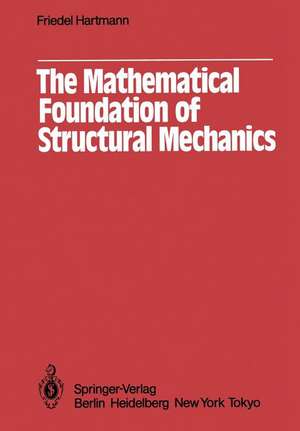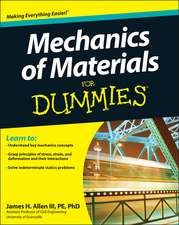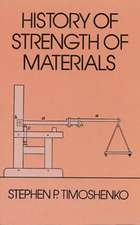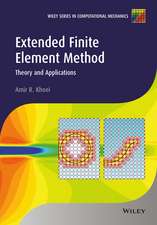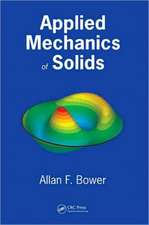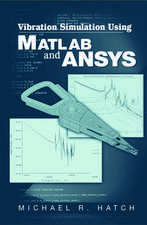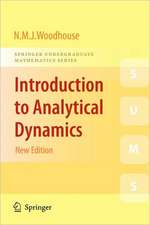The Mathematical Foundation of Structural Mechanics
Autor F. Hartmannen Limba Engleză Paperback – 15 dec 2011
Preț: 534.69 lei
Preț vechi: 629.04 lei
-15% Nou
Puncte Express: 802
Preț estimativ în valută:
102.32€ • 109.41$ • 85.31£
102.32€ • 109.41$ • 85.31£
Carte tipărită la comandă
Livrare economică 18 aprilie-02 mai
Preluare comenzi: 021 569.72.76
Specificații
ISBN-13: 9783642824036
ISBN-10: 364282403X
Pagini: 388
Ilustrații: XII, 371 p.
Dimensiuni: 170 x 244 x 25 mm
Greutate: 0.62 kg
Ediția:Softcover reprint of the original 1st ed. 1985
Editura: Springer Berlin, Heidelberg
Colecția Springer
Locul publicării:Berlin, Heidelberg, Germany
ISBN-10: 364282403X
Pagini: 388
Ilustrații: XII, 371 p.
Dimensiuni: 170 x 244 x 25 mm
Greutate: 0.62 kg
Ediția:Softcover reprint of the original 1st ed. 1985
Editura: Springer Berlin, Heidelberg
Colecția Springer
Locul publicării:Berlin, Heidelberg, Germany
Public țintă
GraduateCuprins
1 Fundamentals.- 1.1 Vectors and Matrices.- 1.2 Differentiation.- 1.3 Domains.- 1.4 Integrals.- 1.5 Integration by Parts.- 1.6 Gateaux Differentials.- 1.7 Functionals.- 1.8 Sobolev Spaces.- 1.9 The Differential Equations.- 2 Work and Energy.- 2.1 Integral Identities.- 2.2 Summary.- 2.3 Three Corollaries.- 2.4 A Beam.- 2.5 Eigenwork = Internal Energy.- 2.6 Equilibrium.- 2.7 Summation of Work and Energy.- 2.8 Rigid Supports and free Boundaries.- 2.9 Elastic Supports.- 2.10 The Mathematical Basis of Structural Mechanics.- 2.11 The Space $${C^{2m}}(\bar \Omega)$$ and its Limitations.- 3 Continuous Beams, Trusses and Frames.- 3.1 Continuous Beams.- 3.2 Trusses.- 3.3 Frames.- 3.4 Stiffness Matrices.- 4 Energy Principles.- 4.1 The Basic Principle.- 4.2 Examples.- 4.3 The Principle of Minimum Potential Energy.- 4.4 The Complementary Principle.- 4.5 The Formulation of ?1 (u) and ?2 (u).- 4.6 The Sign of the Total Energy.- 4.7 The Point ? (w) and the Classes R1 and R2.- 4.8 Displacement Method and Force Method.- 4.9 Energy Principles for Cont. Beams, Trusses and Frames.- 4.10 The Formulation of the Functional “by hand”.- 4.11 Lagrange Multipliers.- 4.12 The Algebra of Structural Mechanics.- 5 Concentrated Forces.- 5.1 Fundamental Solutions.- 5.2 Fundamental Solutions and Integral Identities.- 5.3 Results.- 5.4 Summary.- 5.5 An Extension.- 5.6 Theorems “eigenwork = int. energy”.- 5.7 The Characteristic Functions.- 5.8 An Alternative.- 5.9 Castigliano’s Theorem.- 5.10 Castigliano’s Generalized Theorem.- 5.11 Concentrated Forces or Disturbances on the Boundary.- 6 Influence Functions.- 6.1 Integral Representations.- 6.2 Green’s function.- 6.3 Compatibility on the Boundary.- 6.4 Summary.- 6.5 An Example.- 6.6 Stiffness Matrices and Compatibility Conditions.- 6.7 TheBoundary Element Method.- 6.8 The Trace Theorem.- 6.9 Elastic Potentials.- 7 The Operators A.- 7.1 The Systems.- 7.2 Identities.- 7.3 Energy Principles.- 7.4 Sufficient Conditions.- 7.5 Other Mixed Formulations.- 7.6 The Babuška-Brezzi Condition.- 8 Shells.- 8.1 Shells as Surfaces.- 8.2 Statics.- 8.3 Koiter’s Model.- 8.4 The first Identity.- 9 Second-Order Analysis.- 9.1 Beams.- 9.2 Stability.- 9.3 Lateral Buckling of Beams.- 9.4 The Kirchhoff Plate.- 9.5 Nonconservative Problems.- 9.6 Initial Value Problems.- 9.7 Vibrations.- 9.8 Hamilton’s Principle.- 10 Nonlinear Theory of Elasticity.- 10.1 The Differential Equations.- 10.2 The first Identity.- 10.3 Energy Principles.- 10.4 Incremental Procedures.- 10.5 Large Displacement Analysis of Beams.- 10.6 Large Displacement Analysis of Plates.- 10.7 The Principle “eigenwork = int. energy”.- 10.8 Influence Functions.- 11 Finite Elements.- 11.1 Shape Functions.- 11.2 The Error in Finite Elements.- 11.3 Nonconforming Shape Functions.- 11.4 The Patch Test.- 11.5 Hybrid Energy Principles.- 11.6 Hybrid Energy Principles for Operators A.- 12 References.- 13 Subject Index.
